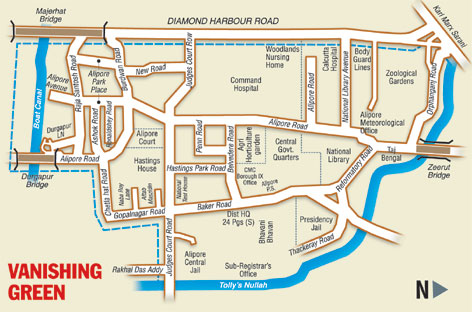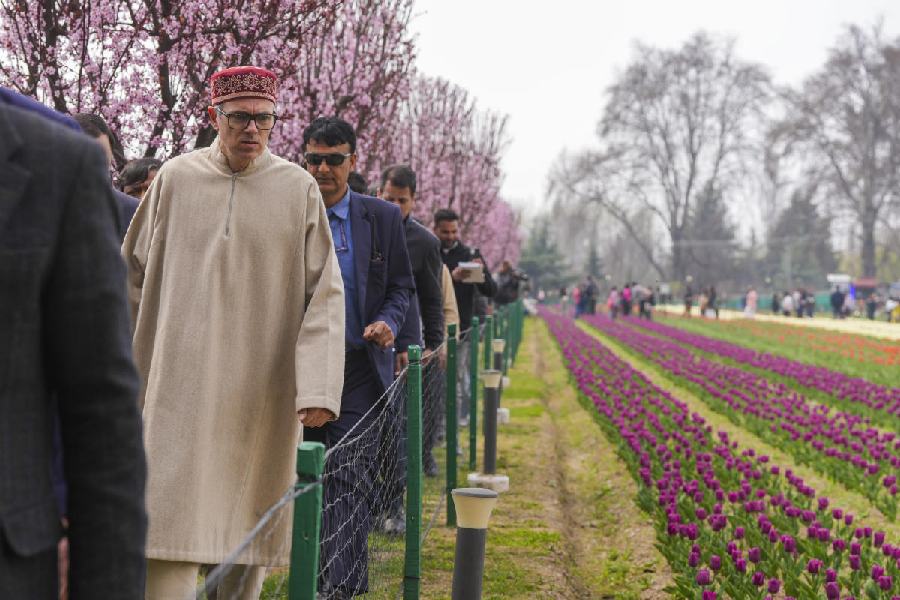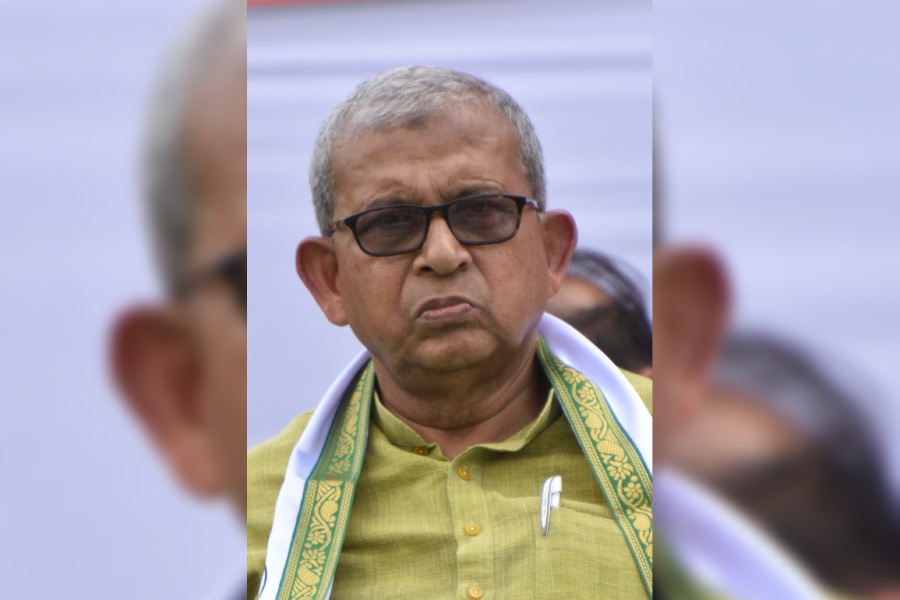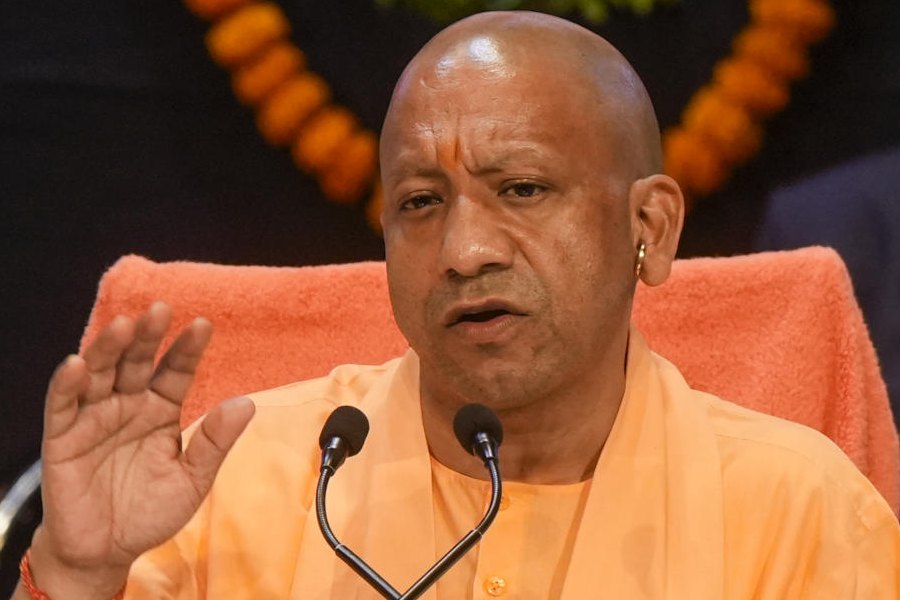 |
The first time I ever wore chiffon was when I was a little over three. I was in nursery then, and a girl named Uma Jalan had invited the whole class to her birthday party where we were to go in fancy dress. Hence the sari.
The only thing I remember of that visit was tripping over my drape as I tried to run over what seemed acres of marble. And every time we passed by Jalan House on Alipore Road the brown stone plaque with the family name inscribed on it would be pointed out to me.
When I went back to the same house 50 years later to meet Sudhir Jalan, I was wondering if the private petrol station I was convinced I had seen as a child, existed in reality. I was soon to find out that it did not, and my pixilated memory was up to its tricks once again. But he confirmed that he did have a cousin named Uma, who grew up there.
Jalan explained that earlier the entrance used to be from Alipore Road, but because of the rush of vehicles on that thoroughfare today, ingress is through the relatively peaceful Penn Road.
The house is a three-storeyed affair with glass panes. It is a building typical of the 1950s, inspired, however remotely, by art deco, or closer home, Metro cinema. As the British burrasaabs of companies began to return home, their beautiful garden houses were taken over by the Marwari industrialists and businessmen, soon to be converted into buildings such as these that provided more floorspace to accommodate large joint families. As utilitarian concerns smothered the desire for and availability of more personal space, Alipore?s green cover began to thin.
Now even the buildings with large lawns surrounded by cliff-like walls are not immune to the din of building hyperactivity in Alipore, and the fumes of thousands of vehicles thundering down once-deserted avenues.
Such is the frenetic pace at which a new Alipore of condominiums is coming up that the Sahu Jain house in Alipore Park Road will soon make way for a highrise.
This house had, in the past, played host to many an eminent artiste. Pradip Sureka of South City, which is developing the property, said the lush greenery will be retained.
Neither Abanindranath in Rajkahini nor Rajshekhar Basu in his writings was very charitably inclined to the Marwaris. But instead of emotion getting the upperhand, it is better to stick to facts.
In early 20th century, although Bengali merchants outnumbered Marwari or Gujarati tradespeople, Bengali capital was highly fragmented, and was in the kindergarten stage as it still is now.
Bengalis of that period did not lack enterprise but were not blessed with the capacity to sustain their endeavours. Impulsive as they were they threw themselves headlong into the swadeshi movement, without sparing much thought for practical considerations.
The Marwaris hardly carried similar ideological baggage (the likes of Ghanashyam Das Birla, notwithstanding), and had by 19th-century end, appropriated the indigenous banking system as well as those of cotton and jute.
With the decline of imperial power and the consequent enervation of British managing agencies, they transformed from traders and moneylenders to entrepreneurs. The industriousness, business acumen and diligence of this close-knit community for whom loyalty to one?s kin was like a religion certainly helped.
By 1930, Marwaris headed the majority of jute mill companies and almost half of collieries. By 1948, their shares increased. By the 1960s, they had become the new economic elite of this region.
Anthony Hayward, the last British burrasaab of Shaw Wallace, who lived in Raja Santosh Road in the early Seventies and who visits the city every winter, had written about the entry of Marwari millionaires in Alipore in an e-mail: ?The Marwaris came to live in Alipore by virtue of the fact that they bought up all the managing agency houses in Calcutta over the period between 1947 and 1967; and with them the big houses which belonged to those companies. Development continued apace, and by the time I left in 1978 I dare say that 20 or more houses had been demolished and highrises built. It was started perhaps by ICI and Imperial Tobacco, and Mackinnon Mackenzie who knocked down their big houses, and built half a dozen or more perfectly large and adequate houses for their directors, not highrises.?
Like many famous Marwari families of the city, the Jalans were from Ratangarh in Shekhawati, and they settled in north Calcutta more than a century ago. The Jalans had reconstructed the Alipore house bought from an Englishman and both Sudhirbabu?s father and uncle live there.
The Singhanias and the Goenkas were already there. Jit Paul and the Bajorias came later.
?It used to be so lonely here that we could hear lions roar in the zoo, and the maids used to scare us with them. Penn Road was cobbled and it used to be so dark and deserted it was considered unsafe,? said Jalan in fluent Bengali. His wife Alka from Jalpaiguri speaks the language even more fluently.
Alipore was a tough assignment and I was in despair of ever getting past sundry cerebuses and secretaries innocent of the electronic media, and finally establish contact with these magnates. Even when I managed to do so, more often than not, they were leaving for a business trip abroad in a few hours? time.
Without the good offices of a lady of the house it would have been impossible to meet S.K. Birla. The greenery in Birla enclave on Raja Santosh Road ? which he later described as once being in the ?extremity of civilisation? ? is perfectly manicured. In front of the house is a woman of marble sculpted Geet Gaya Paththaron Ne style.
The Birlas originally lived in Kaligudam near Kalakar Street. This house was constructed in 1943, but the American army took it over. Supported by America, China was putting up a resistance to Japan.
At this time, the Chinese were guests of GD Birla. Food, weapons and provisions were sent from Calcutta. Pilots needed extra skill to manoeuvre the propeller planes over the Himalayas.
?This house was the base for training and administration. When we moved in 1947, the floors were broken, and on the walls were sketches of angles at which planes flew. We were the first in the family to come to Alipore. The second was BM Birla in 1953. R.P. Goenka?s house was being constructed then,? said S.K. Birla.
He spoke of the company bungalows, of Anthony Hayward at No 16 Raja Santosh Road, the pot-holed road, the trees and Woodlands, which belonged to the Cooch Behar royal family but was sold in 1950. The sale of the Burdwan royal family property began a few years later.
BM Birla built his house in the Woodlands property, where the nursing home still bears its name.
After calling up Jagmohan Dalmiya at all the unearthly hours of day at home and at his office I was finally able to meet him in his office on Shakespeare Sarani, a renovated bungalow that used to be a police station. The Indo-Pak cricket match was giving him sleepless nights.
He said his father had bought the Woodlands property. It was later sold plot by plot. Their Alipore Road house originally belonged to a sahib. ?Command Hospital had not come up and cricket matches were held in Woodlands. Jackals used to move around the military area. The area was so deserted we had to keep a guard dog.?
Next Sunday when I went to see his house, I had to sit for a seemingly endless hour in the company of three huge German shepherds, my heart in my mouth.
At the entrance were installed the images of Ramakrishna and Sarada Debi. Dalmiya?s wife is a daughter of the Ghosh family of Pathuriaghat. The living room and the dining hall could have been from a 1970s Bollywood production, tinselly yet tatty.
S.K. Birla had said the Goenkas were the original seths of Calcutta. But the opulence of the house on Belvedere Raod could not ward off the roar of traffic without.
Sanjeev Goenka said the height of the walls had to be raised to keep out the noise of traffic. Weddings in the Agri-Horticultural Garden added to the chaos.
Of the new houses, Shishir Bajoria?s is the smartest. It is a spare unadorned affair on Burdwan Road with a huge dramatic window overlooking the lawn. Belonging to the new generation of Marwaris his acculturation is quite remarkable from his fluency in Bengali to his taste (rather his wife?s) in art. ?I have been to my ancestral home in Rajasthan only twice. Once for my mundan and now for my son?s,? says Bajoria.
M.K. Jalan?s eyrie on the 11th and 12th floors of Sriram Gardens commands a view of not only leafy Alipore but way beyond. A relatively new entrant to Calcutta, Jalan began living in this city from 1978, and in this house at the Belvedere Road-Alipore Road crossing since 1988.
He has laid out the perfect garden on the terrace with a wealth of creepers and fountains. A dove flying past alighted on top of the living room door. It was gone the next moment. The quality of air is bound to be good here.
Mahesh Sahariya?s New Road is without a single highrise. The Command Hospital plot is a low football field. Cricketer Prabir Sen is at 3 New Road, a thoroughfare where he lives now. The Reserve Bank quarters came up in the early 1950s. Like most longtime residents of Alipore, Sahariya speaks of a ?sense of awe and dignity? there.
Of all the Alipore residents I met, Gaurav Swarup has perhaps the finest sense of history. From Uttar Pradesh, he lives in one of the five bungalows that went by the name of Whitehouse, now splintered into a few more properties.
He actually took the trouble of taking out the handwritten documents pertaining to his property at 1B Judge?s Court Road. It showed that it once belonged to one Manick Lal Seal of Lower Chitpore Road and was sold to National Bank in 1929.
To be continued











